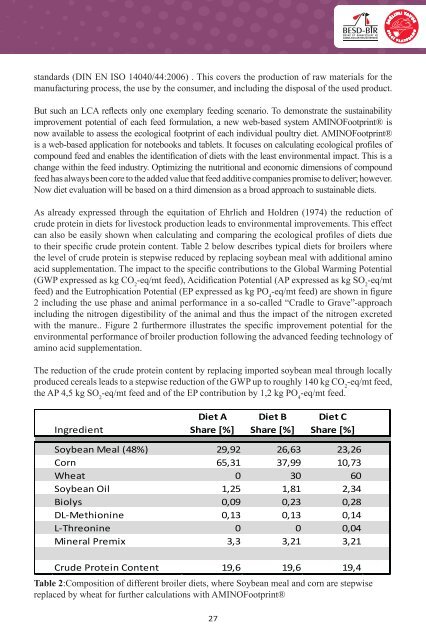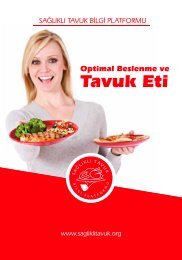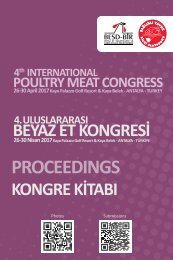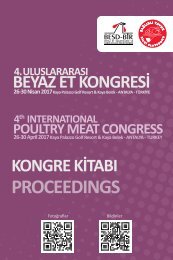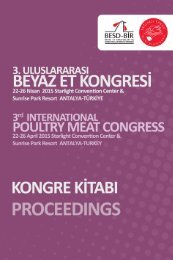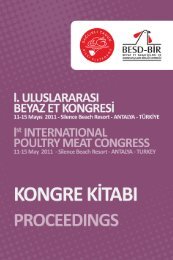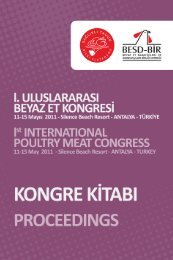3rd International Poultry Meat Congress
Proceedings
Proceedings
Create successful ePaper yourself
Turn your PDF publications into a flip-book with our unique Google optimized e-Paper software.
standards (DIN EN ISO 14040/44:2006) . This covers the production of raw materials for the<br />
manufacturing process, the use by the consumer, and including the disposal of the used product.<br />
But such an LCA reflects only one exemplary feeding scenario. To demonstrate the sustainability<br />
improvement potential of each feed formulation, a new web-based system AMINOFootprint® is<br />
now available to assess the ecological footprint of each individual poultry diet. AMINOFootprint®<br />
is a web-based application for notebooks and tablets. It focuses on calculating ecological profiles of<br />
compound feed and enables the identification of diets with the least environmental impact. This is a<br />
change within the feed industry. Optimizing the nutritional and economic dimensions of compound<br />
feed has always been core to the added value that feed additive companies promise to deliver; however.<br />
Now diet evaluation will be based on a third dimension as a broad approach to sustainable diets.<br />
As already expressed through the equitation of Ehrlich and Holdren (1974) the reduction of<br />
crude protein in diets for livestock production leads to environmental improvements. This effect<br />
can also be easily shown when calculating and comparing the ecological profiles of diets due<br />
to their specific crude protein content. Table 2 below describes typical diets for broilers where<br />
the level of crude protein is stepwise reduced by replacing soybean meal with additional amino<br />
acid supplementation. The impact to the specific contributions to the Global Warming Potential<br />
(GWP expressed as kg CO 2<br />
-eq/mt feed), Acidification Potential (AP expressed as kg SO 2<br />
-eq/mt<br />
feed) and the Eutrophication Potential (EP expressed as kg PO 4<br />
-eq/mt feed) are shown in figure<br />
2 including the use phase and animal performance in a so-called “Cradle to Grave”-approach<br />
including the nitrogen digestibility of the animal and thus the impact of the nitrogen excreted<br />
with the manure.. Figure 2 furthermore illustrates the specific improvement potential for the<br />
environmental performance of broiler production following the advanced feeding technology of<br />
amino acid supplementation.<br />
The reduction of the crude protein content by replacing imported soybean meal through locally<br />
produced cereals leads to a stepwise reduction of the GWP up to roughly 140 kg CO 2<br />
-eq/mt feed,<br />
the AP 4,5 kg SO 2<br />
-eq/mt feed and of the EP contribution by 1,2 kg PO 4<br />
-eq/mt feed.<br />
Diet A Diet B Diet C<br />
Ingredient Share [%] Share [%] Share [%]<br />
Soybean Meal (48%) 29,92 26,63 23,26<br />
Corn 65,31 37,99 10,73<br />
Wheat 0 30 60<br />
Soybean Oil 1,25 1,81 2,34<br />
Biolys 0,09 0,23 0,28<br />
DL-Methionine 0,13 0,13 0,14<br />
L-Threonine 0 0 0,04<br />
Mineral Premix 3,3 3,21 3,21<br />
Crude Protein Content 19,6 19,6 19,4<br />
Table 2:Composition of different broiler diets, where Soybean meal and corn are stepwise<br />
replaced by wheat for further calculations with AMINOFootprint®<br />
27


